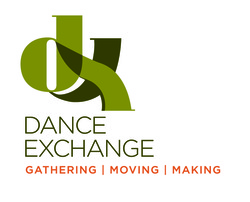 This past summer, I worked with Dance Exchange as part of their annual Summer Institute, which brought together artists, activists from all over the U.S. and Canada. During this 10-day intensive, we guided participants through inquiry, generative dialogue, moving and creative practices that yield strategies for advancing racial equity through the arts. On our first day, we worked with Race Forward Associate Trainers, Tammy Johnson and Nayantara Sen. Race Forward is a national racial justice organization that advances racial justice through research, media and practice. Founded in 1981, Race Forward brings systemic analysis and an innovative approach to complex race issues to help people take effective action toward racial equity. Race Forward publishes the daily news site Colorlines and presents Facing Race, the country’s largest multiracial conference on racial justice. Their interactive training exposed us language concepts and tools for racial justice and equity building. Using movement, hands-on exercise, discussion and application, participants so that we could build on our capacity to address structural racism and implicit bias in the arts. We began our day learning the Key Concepts: Key Concepts- Justice is not Diversity. Diversity is Variety. - Justice is not Equality. Equality is Sameness, and the truth of the matter is we are not the same. We come from radically different cultures, experiences, educational opportunities. - Justice is Equity. Equity means we are treated with fairness and justice. Now, my question is why do we have a wall at all, but this leads us to a conversation about liberation. Only, let's not get ahead of ourselves. We've got to prepare for the revolution first! From there, we defined Racial Justice and Systemic Equity:
This is critical because as we work to dismantle various systems, practices, and ideologies of oppression including, but not limited to racism and sexism, we have to replace them with systems, practices and ideology of Racial and Gender Equity. Individual-Level Racism
Systemic-level Racism
All of what was shared is part of a report, Moving the Race Conversation Forward, by Race Forward: The Center for Racial Justice Innovation that aims to reshape and reform the way we talk about race and racism in our country. The paper includes content analysis of mainstream media (finding two-thirds of race-focused media coverage fails to consider systemic racism), analysis of seven harmful racial discourse practices, and case studies of successful interventions to counteract these trends. This video, produced by Jay Smooth, expands on the report's analysis of media's failure to consider systemic racism. Smooth is the founder of New York's longest running hip-hop radio show, WBAI's Underground Railroad, and Race Forward Video & Multimedia Producer. Moving the Race Conversation ForwardOkay, now that you know how to talk about racism, here are three tips for addressing racism:
Strategies for Addressing Racism at Different Levels
From there, we watched this excellent presentation, Immaculate Perception by Jerry Kang, which helped up to see how explicit and implicit bias works in real life. Makers, Artmakers, Peacemakers: Immaculate perception? "Do you discriminate? UCLA law professor Jerry Kang exposes the phenomenon of automatic processing and how it relates to explicit and implicit bias. Decades of research shows that attitudes and stereotypes influence how we see and behave. Despite our best efforts, are we all under the sway of "the rightness of whiteness?" And is there evidence showing that these biases can be reduced -- at least temporarily? Using humor and audience participation, Kang challenges our assumptions while shifting our perceptions of at least one Asian male." Understanding Implicit Bias and How to Identify and Disrupt ItImplicit Biases are pervasive • People are often unaware of their implicit bias • Implicit biases predict behavior • People differ in levels of implicit bias Implicit Bias is Individual AND Institutional: • A lot of racial inequities occur without intention or malice. It does not require “racists. ” Implicit bias helps explain how racism can be subtle in appearance but significant in impact. • In institutions, the bias of individuals is routinely replicated through collective decisions and actions. It becomes compounded unless it’s consciously counteracted. • “Implicit Bias…offers the idea that discrimination and bias are social, rather than individual issues, and that we can thus all participate in promoting equality.” --American Values Project Implicit Bias and Public Policy • Most policies are facially neutral (race silent) but not racially neutral—they have negative or positive racial impacts. • Negative racial impacts may or may not have been intentional. Positive racial impacts often require intentionality. • When racial impacts are not consciously considered during the lawmaking/decision-making process, there is more likelihood that negative racial impacts will result-- implicit bias is the default. Choice Points • Choice points are decision-making opportunities that influence outcomes. • The cumulative impacts of many small choices can be as significant as the impacts of big decisions. • When we’re conscious of choice points and the related impacts, we’re less likely to replicate implicit bias and the status quo, and we open new possibilities for equitable change. Using Choice Points to Advance Equity
Racial Equity Impact Assessment OverviewWhat are Racial Equity Impact Assessments? A Racial Equity Impact Assessment (REIA) is a systematic examination of how different racial and ethnic groups will likely be affected by a proposed action or decision. REIAs are used to minimize unanticipated adverse consequences in a variety of contexts, including the analysis of proposed policies, institutional practices, programs, plans and budgetary decisions. The REIA can be a vital tool for preventing institutional racism and for identifying new options to remedy long-standing inequities. Why are they needed? REIAs are used to reduce, eliminate and prevent racial discrimination and inequities. The persistence of deep racial disparities and divisions across society is evidence of institutional racism––the routine, often invisible and unintentional, production of inequitable social opportunities and outcomes. When racial equity is not consciously addressed, racial inequality is often unconsciously replicated. When should it be conducted? REIAs are best conducted during the decision-making process, prior to enacting new proposals. They are used to inform decisions, much like environmental impact statements, fiscal impact reports and workplace risk assessments. Racial Equity Impact Assessment GuideBelow are sample questions to use to anticipate, assess and prevent potential adverse consequences of proposed actions on different racial groups. 1. Identifying Stakeholders Which racial/ethnic groups may be most affected by and concerned with the issues related to this proposal? 2. Engaging Stakeholders Have stakeholders from different racial/ethnic groups—especially those most adversely affected—been informed, meaningfully involved and authentically represented in the development of this proposal? Who’s missing and how can they be engaged? 3. Identifying and Documenting Racial Inequities Which racial/ethnic groups are currently most advantaged and most disadvantaged by the issues this proposal seeks to address? How are they affected differently? What quantitative and qualitative evidence of inequality exists? What evidence is missing or needed? 4. Examining the Causes What factors may be producing and perpetuating racial inequities associated with this issue? How did the inequities arise? Are they expanding or narrowing? Does the proposal address root causes? If not, how could it? 5. Clarifying the Purpose What does the proposal seek to accomplish? Will it reduce disparities or discrimination 6. Considering Adverse Impacts What adverse impacts or unintended consequences could result from this policy? Which racial/ethnic groups could be negatively affected? How could adverse impacts be prevented or minimized? 7. Advancing Equitable Impacts What positive impacts on equality and inclusion, if any, could result from this proposal? Which racial/ethnic groups could benefit? Are there further ways to maximize equitable opportunities and impacts? 8. Examining Alternatives or Improvements Are there better ways to reduce racial disparities and advance racial equity? What provisions could be changed or added to ensure positive impacts on racial equity and inclusion? 9. Ensuring Viability and Sustainability Is the proposal realistic, adequately funded, with mechanisms to ensure successful implementation and enforcement. Are there provisions to ensure ongoing data collection, public reporting, stakeholder participation and public accountability? 10. Identifying Success Indicators What are the success indicators and progress benchmarks? How will impacts be documented and evaluated? How will the level, diversity and quality of ongoing stakeholder engagement be assessed? This session was a comprehensive introduction to the Race Forward national conference, which I was fortunate enough to attend and also blog about to capture my experience. My next several post will give you a bit of insight into what I learned there.
0 Comments
Your comment will be posted after it is approved.
Leave a Reply. |
My BlogI'm a playwright, dramaturg, and teaching artist. It is here where you'll find my queries and musings on life, theater and the world. My posts advocate for diversity, inclusion, and equity in the American Theatre and updates on my own work. Please enjoy!
Categories
All
Archives
June 2020
Reading List
|
